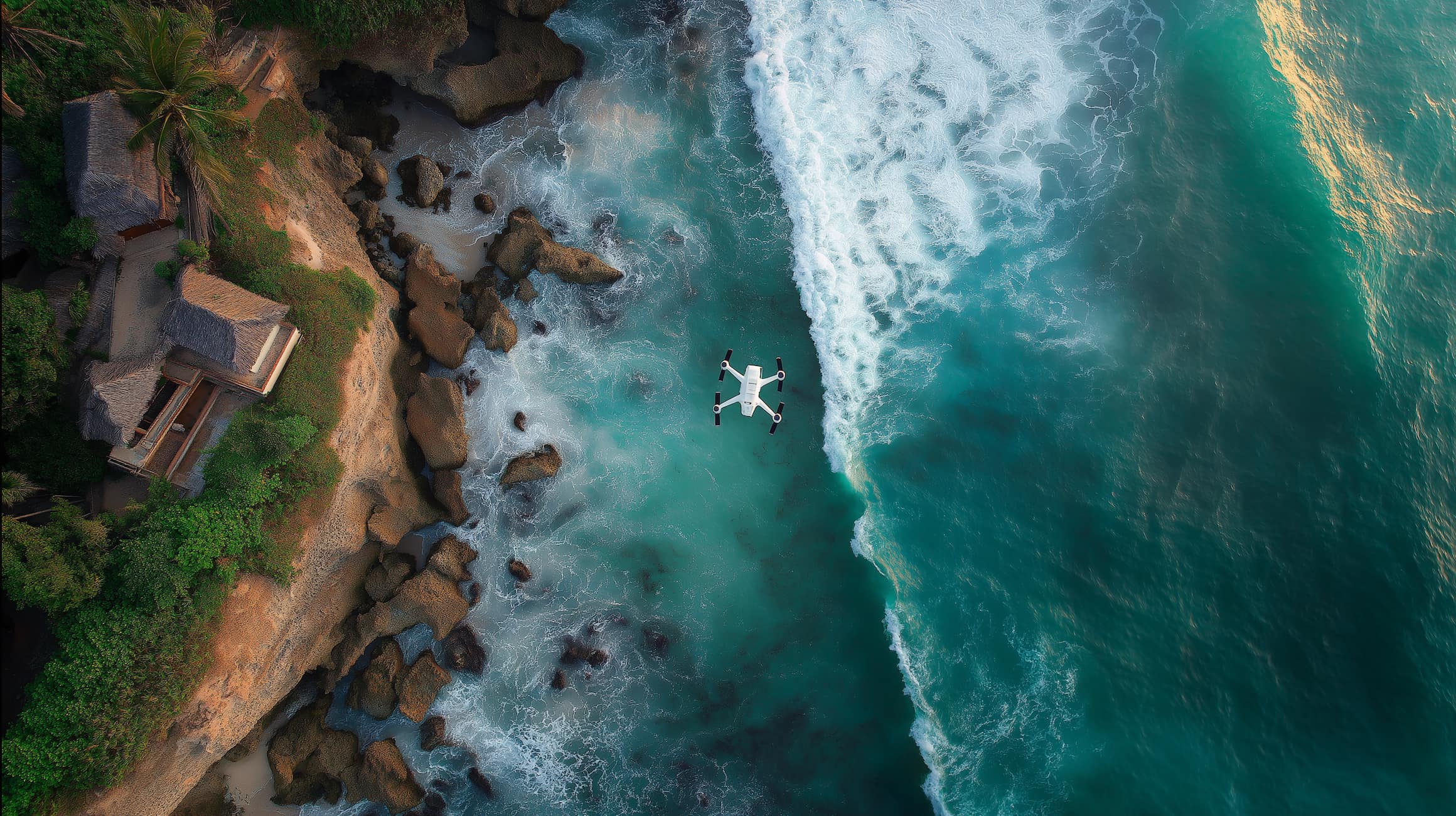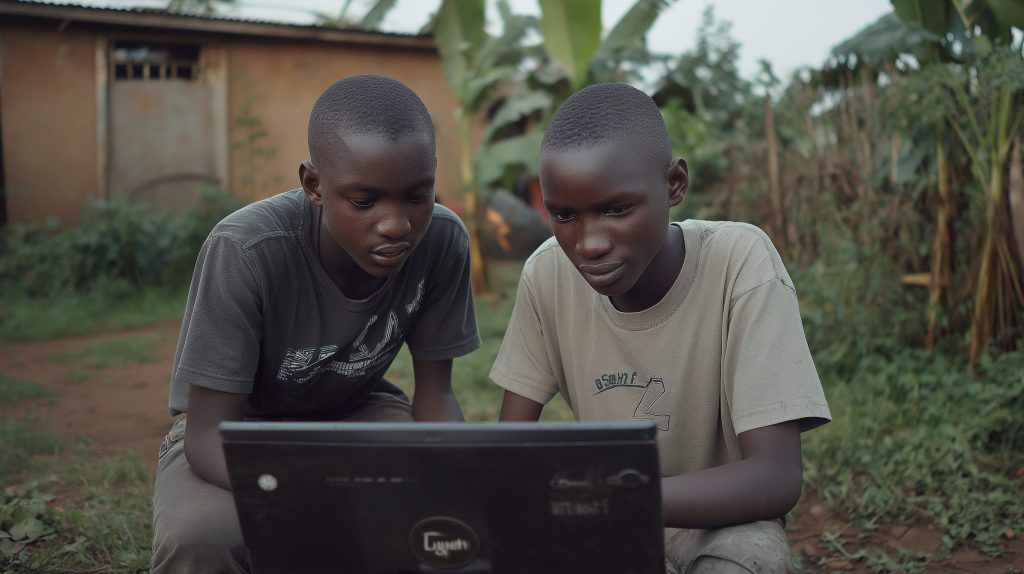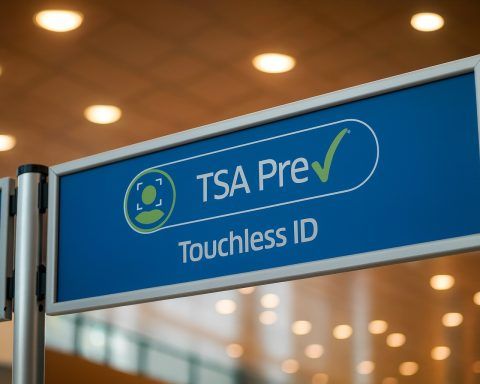- The maximum legal drone altitude in Bali is 150 meters above ground, and flying higher requires explicit permission from the DGCA.
- All drones must be registered with the DGCA via the SIPUDI online system, with a registration certificate valid for 3 years and the drone labeled with its unique registration number.
- A Remote Pilot License (RPL) is required for any commercial or professional drone use, with training, a written exam, and a flight test, and the license is typically valid for 2–3 years.
- For recreational use (Category 1), drones under 2 kg require no permit, while drones over 2 kg require a DGCA flight permit.
- For commercial or business use (Category 2), drones under 2 kg require a pilot license and insurance but no permit, while drones over 2 kg require a DGCA permit plus a license and insurance.
- Drones must be flown within Visual Line of Sight (VLOS) at all times, and Beyond Visual Line of Sight (BVLOS) flights are not allowed for civilians without a special DGCA permit.
- All drone operations must occur in daylight and good weather, with night flying prohibited unless a special waiver is granted.
- Airports and flight paths are no-fly zones with a minimum KKOP radius around Ngurah Rai International Airport of at least 9 km (5–6 miles) from the airport.
- Temples and religious sites are no-fly zones unless you obtain explicit permission from temple management or local authorities.
- Penalties for violations include administrative fines up to IDR 1.5 billion, criminal penalties up to 5 years in prison and up to IDR 5 billion in fines, and possible drone confiscation, with foreigners potentially facing deportation.
Bali’s breathtaking landscapes make it a paradise for drone photography, but flying a drone in Bali comes with strict laws in 2025. Indonesia (including Bali) has tightened its drone regulations to ensure safety, privacy, and security. Drones are legal to fly in Bali, but you must follow national rules and local restrictions to avoid hefty fines, confiscation of your drone, or worse. In this guide, we break down everything you need to know – from permits and licensing to no-fly zones around temples and airports, as well as recent updates and tips for tourists. Keep reading before you take off, so you don’t end up on the wrong side of the law.
To get started, here’s a quick overview of the key drone rules and requirements in Bali (Indonesia) as of 2025:
| Rule / Aspect | Bali Drone Regulations (2025) |
|---|---|
| Drone Categories & Permits | – Recreational (Category 1): No permit required if drone < 2 kg [1]. Drones > 2 kg need a flight permit from the Civil Aviation Authority [2]. – Commercial (Category 2): No permit for < 2 kg, but pilot must be licensed and drone insured [3]. Drones > 2 kg require a DGCA permit plus a license and insurance [4]. (DGCA = Directorate General of Civil Aviation) |
| Remote Pilot License (RPL) | Required for any commercial or professional drone use. To get an RPL, pilots undergo training, a written exam, and a flight test; licenses are valid ~2–3 years [5]. Hobbyist flights strictly for fun don’t need an RPL, but it’s highly recommended to at least know the rules [6] [7]. |
| Drone Registration | All drones should be registered with the DGCA via the online system (SIPUDI). Registration is valid for 3 years and requires details of the drone (make, serial no., weight) and proof of insurance [8]. You must mark the drone with its registration number, and flying an unregistered drone can lead to penalties [9]. (In practice, many tourists fly small drones without registering, but this is technically against the law.) |
| Max Altitude | 150 meters (≈500 feet) above ground is the maximum legal altitude for drones [10]. Flying higher requires special permission from DGCA. Keep well below this limit near any airports or flight paths (in controlled airspace near airports, the effective altitude limit is 0 feet – no drone flights at all without explicit permit) [11] [12]. |
| Flight Range (VLOS) | Drones must be kept within Visual Line of Sight (VLOS) of the operator at all times [13]. You cannot fly beyond the distance you can see the drone with the naked eye. First-person view (FPV) goggles are allowed for view, but you (or a spotter) still need direct visual contact with the drone [14]. Beyond-Visual-Line-of-Sight (BVLOS) flights are not allowed for civilians unless you have a special DGCA permit for specific operations [15]. |
| Time of Operation | Daylight only. Flying at night is prohibited without special authorization [16]. Operations must be done in good weather (clear conditions). No flying in heavy rain, fog, or other low-visibility conditions for safety [17]. |
| No-Fly Zones: Airports | Airports are strict no-fly zones. Do not fly within the airport safety zone (KKOP) around any airport [18]. In practice this means at least 9 km (~5.6 miles) radius from Bali’s airports (e.g. Ngurah Rai International in Denpasar) is off-limits for drones [19] [20]. Flying near runways or flight paths can lead to immediate drone confiscation and severe penalties [21]. |
| No-Fly Zones: Temples & Cultural Sites | Temples and religious ceremonies are off-limits without explicit permission. Bali authorities prohibit drones around temples out of respect and to avoid disruption [22]. Never fly over temple grounds or during prayer sessions – this could get you in serious trouble with local community guards (pecalang) or police [23]. Always keep a good distance unless you have obtained permission for a special event. |
| No-Fly Zones: Government & Military | Sensitive government, military, and critical infrastructure sites are no-fly zones. Drones must stay at least 500 m (0.5 km) away from prohibited areas like presidential palaces, military bases, government complexes, or nuclear facilities [24]. These areas are usually designated as Prohibited or Restricted airspace under Indonesian law – flying a drone there is strictly banned for security reasons. If you are caught flying near a military or government site, expect your drone to be seized and possibly face heavy fines [25] [26]. |
| Crowds and Privacy | No flying over crowds or public gatherings. It’s illegal to fly over groups of people, busy beaches, festivals, or any crowded area [27]. Always keep at least 50 m distance from people not involved in the drone operation [28]. Respect privacy – do not film people at close range or on private property without consent [29]. Peeking into someone’s home or resort with a drone camera can lead to complaints or legal trouble under privacy laws. |
| Insurance Requirements | Liability insurance is mandatory for any drone operations that require a permit (e.g. most commercial flights or heavier drones) [30]. You should have third-party liability insurance coverage (often in the hundreds of millions of IDR) to cover any damage or injury your drone might cause [31]. Proof of insurance is required when applying for permits and you should carry it when flying in case authorities ask [32]. (For casual hobby fliers with small drones, insurance might not be legally required if you don’t need a permit – but it’s strongly advised to have coverage regardless.) |
| Penalties for Violations | Breaking drone laws in Bali/Indonesia can lead to steep penalties. Administrative fines can reach IDR 1.5 billion (over USD 100,000) even for non-criminal violations [33]. Serious offenses (e.g. endangering aircraft or flying in restricted zones) carry criminal penalties up to 5 years in prison and IDR 5 billion in fines (≈ USD 330,000) [34]. Authorities will confiscate your drone if you fly in forbidden areas or violate rules [35]. Foreigners may additionally face deportation for breaking laws or visa rules by misusing drones. In short, the consequences are severe – always fly responsibly. |
Table: Summary of key drone rules and requirements in Bali (Indonesia) as of 2025.
Below, we explore each of these aspects in detail, along with recent updates and practical tips for tourists and drone enthusiasts planning to fly in Bali.
Permit and Licensing Requirements in Bali
Indonesia categorizes drones by use and weight, which determines if you need permits or licenses. For recreational use (Category 1), flying a small drone is relatively straightforward: if your drone weighs under 2 kg (4.4 lbs), you do not need prior permission from authorities [36]. This covers most consumer drones like DJI Mavic or Phantom. However, if your hobby drone is over 2 kg, Indonesian law technically requires you to obtain a flight permit from the Director General of Civil Aviation (DGCA) before flying [37]. In practice, very few tourists use drones heavier than 2 kg, but it’s important to know this threshold exists.
For commercial or business use (Category 2), the rules are stricter. Even if the drone is small, pilots must be licensed and the drone insured for liability [38]. No permit is needed for commercial drones under 2 kg beyond having a license/insurance, but if the drone weighs more than 2 kg, a DGCA permit is required in addition to the pilot’s license and insurance documents [39]. In other words, a wedding photographer or a videographer using a heavy drone in Bali would need to go through an approval process. Foreign operators cannot simply bring a big drone and start working commercially; they generally must partner with a locally licensed operator or go through local permitting channels [40].
Remote Pilot License (RPL): Indonesia has a certification system for drone pilots. Anyone flying a drone commercially or for non-recreational purposes must hold a Remote Pilot License issued by the DGCA [41]. To get an RPL, you need to complete training at a DGCA-approved school, pass a written knowledge exam on aviation rules, and pass a practical flight test [42]. The license is typically valid for 2–3 years and demonstrates you understand how to fly safely and legally. Recreational hobbyists flying just for fun don’t need an RPL if they stay within the hobby limits (small drone, below 150 m, away from no-fly zones). However, it’s highly recommended even for hobbyists to familiarize themselves with the rules – Indonesia treats drone operations seriously, and having at least some form of competency proof can be helpful [43] [44]. If an officer questions your flying, being able to show a certificate or evidence of training (even informal) can smooth things over.
Drone Registration: Indonesia introduced mandatory drone registration to keep track of unmanned aircraft. All drones operated in Indonesia should be registered with the DGCA through an online system called SIPUDI (Sistema Informasi Pesawat Udara Tanpa Awak, roughly “Drone Information System”) [45]. When registering, you must provide details like the drone’s make, model, serial number, weight, your contact info, and proof of insurance coverage [46]. Once approved, you receive a registration certificate (valid for 3 years) and a unique registration number for your drone. You’re supposed to label your drone with this number for identification [47]. Operating an unregistered drone is an offense – if you get caught flying a drone that isn’t in the system (especially a larger drone), you could face penalties [48].
Practical note: In reality, registration is more commonly done by residents or commercial operators in Indonesia. Tourists bringing a DJI Mavic Mini or similar for a short visit often do not go through a formal registration process. There is no physical “drone license” sticker checked at the airport, and many visitors do fly unregistered drones recreationally. That said, you are technically required to register, and choosing not to is at your own risk. If something goes wrong or if authorities stop you, the lack of registration could lead to fines. For any serious usage (especially if you’ll fly frequently or for work in Bali), it’s best to register your drone in advance.
Maximum Altitude and Range Limits
Indonesia’s drone laws set clear limits on how high and far you can fly, primarily to keep drones out of manned aircraft airspace and maintain safety.
- Maximum Altitude: Drones in Bali (and the rest of Indonesia) must not fly above 150 meters (approximately 492 feet) above ground level [49]. This altitude cap is in line with many countries’ standards (roughly equivalent to 400–500 feet). It ensures drones stay well below commercial airplanes and most helicopters. If you need to fly higher – for example, for a special survey or a movie production – you must apply for explicit permission from the DGCA ahead of time [50]. Do not attempt to exceed 150 m on your own; not only do many drones have software that caps altitude, but authorities treat higher-altitude flights as serious violations.
- Visual Line of Sight (VLOS): You must keep your drone within your visual line of sight at all times [51]. This means the drone should always be visible to you (the pilot) or a visual observer assisting you. Using binoculars or solely watching through the drone’s camera feed (FPV) does not count – you or an observer need to physically see the aircraft in the sky with unaided eyes [52]. The practical effect is a range limit: even if your drone’s signal could go several kilometers, you usually lose sight of it after a few hundred meters. There’s no exact distance written in the law, but the moment you can’t clearly see your drone, you’re in violation of the VLOS rule. Indonesia currently prohibits Beyond Visual Line of Sight (BVLOS) flights for civilian drone pilots [53]. Only very specific cases (like government-approved projects or research trials) get BVLOS waivers, and those are rare as of 2025 [54].
- Daylight and Weather: All drone flying must be done in daylight hours and in good weather [55]. Night flying is not allowed unless you have a special waiver (which would require you to have anti-collision lights and a strong justification) [56]. Essentially, plan to fly only between sunrise and sunset. Moreover, avoid flying in rain, heavy mist, or high winds – not only for safety of your drone, but because legally you’re expected to fly only in safe conditions with clear visibility [57].
By adhering to the 150 m height limit and keeping your drone within sight, you significantly reduce the chances of a dangerous incident. These rules are enforced; for instance, if an airport radar or local authorities detect a drone above the legal height or reports come in of a drone out of control, you could be tracked down. Bali’s popular viewpoints (clifftops, volcanoes, etc.) might tempt pilots to go high for that epic shot – but resist the temptation to break the altitude rule. Staying within limits is crucial for everyone’s safety and to keep drone flying welcome in Bali.
Restricted No-Fly Zones in Bali
Bali has specific areas where drones are completely forbidden or heavily restricted, on top of the general national no-fly zones. Being aware of these is critical – many tourists have gotten into trouble by unknowingly flying in the wrong place. Here are the main no-fly zones in Bali:
- Airports and Flight Paths: The most important no-fly zones are around airports. Bali’s main airport is Ngurah Rai International Airport (DPS) in Denpasar, and there is discussion of a second airport in North Bali in the future. Indonesian law prohibits drones in what’s called the Kawasan Keselamatan Operasi Penerbangan (KKOP) – basically the flight safety area around airports [58]. This zone is often cited as a radius of about 15 km (9.3 miles) for big airports [59], but at minimum keep 9 km (5–6 miles) away from Ngurah Rai Airport [60]. In simple terms, do not fly a drone anywhere in South Bali near the airport. That includes popular areas like Kuta, Seminyak, or Jimbaran if you’re too close to the flight paths. Even on a beach, if you are in the vicinity of the airport, it’s illegal to launch a drone. There have been cases of tourists fined for flying on beaches within the airport no-fly radius [61]. Always double-check how far you are from an airport – when in doubt, err on the side of being far away. Also avoid flying near heliports or known aircraft routes (for example, tourist areas like Sanur or Nusa Dua occasionally have helicopter tours – be mindful).
- Temples and Religious Sites: Bali is famous for its temples, but temples are drone no-fly areas unless you have permission. Local Balinese Hindu culture considers temples (especially during ceremonies) as sacred spaces that should not be disturbed. Bali’s authorities have explicitly banned drones around temples and religious ceremonies without prior approval [62]. If you fly a drone over a temple during a prayer or festival, expect swift backlash – local community police (known as pecalang) or regular police can confiscate your drone and penalize you [63]. Even if no ceremony is happening, many major temples (like Uluwatu, Tanah Lot, Besakih, etc.) have “No Drones” signs or staff who will stop you from flying. The bottom line: do not fly over temple grounds or crowds of worshippers. If you absolutely need a drone shot of a temple, get permission from temple management or local authorities in advance (and be prepared for them to say no). Often, the answer will be no, to respect religious customs. There are plenty of other scenic spots you can fly without offending the culture.
- Government and Military Zones:Sensitive government buildings, military bases, and infrastructure are off-limits to drones. National law designates certain sites as Prohibited Areas where no aircraft (including drones) can fly at all [64]. These typically include things like presidential palaces, military installations, police headquarters, and sometimes dams or power plants. In Bali, for instance, there is a presidential palace in Tampaksiring (central Bali) – that area is a no-fly zone. There’s also a military airbase co-located with Ngurah Rai Airport and other smaller military installations on the island. Stay at least 500 m (0.5 km) away from any government or military facility [65]. If your drone has a camera (which most do), even flying near these sensitive sites is forbidden, since the law bans aerial surveillance of them. Be mindful of places like police stations or governmental offices – while not all are officially prohibited airspace, flying over them could be interpreted as a security threat. When flying in cities or towns, avoid the downtown government districts.
- National Parks and Wildlife Areas: Bali has some protected natural areas (e.g., West Bali National Park, marine protected zones). While not always explicitly listed in aviation law, many national parks require their own permits for any kind of filming or drone use. For example, if you were to drone around Komodo National Park (in nearby East Nusa Tenggara), you’d need a special permit and to pay fees. In Bali, if you plan to fly in a protected forest or park, check with the park authority. Disturbing wildlife with a drone can get you into trouble. For instance, drones have been banned in some areas of other Indonesian parks after incidents of drones spooking animals [66]. Always research the specific location – a beautiful waterfall or volcano might be in a protected zone where local rules prohibit drones.
- Temporary No-Fly Zones: Be aware that sometimes authorities declare temporary no-fly zones for events or security reasons. In 2022, during the G20 Summit in Bali, drones were heavily restricted over large areas for security [67]. Major international events, VIP visits, or even emergency situations (like a search and rescue, or volcanic eruption) can trigger a temporary ban on drones in the area. These are usually announced via Notices to Airmen (NOTAMs) or public announcements. As a visitor, you might not catch these announcements easily, so it’s wise to avoid flying near any big event venues or crowds unless you have verified it’s allowed.
How to know if an area is a no-fly zone? Indonesia’s AirNav (air traffic control) provides maps and there are smartphone apps and DJI’s geofencing that hint at restricted zones [68]. However, do not rely solely on apps – they might not show cultural no-fly zones like temples or smaller restricted areas. Use common sense: if a location seems sensitive or has signs forbidding drones, don’t fly there. When in doubt, ask local authorities or locals. Many tourist sites in Bali have started putting up signs if drones aren’t allowed. Obey those signs – flying in a no-fly zone can result in immediate confiscation of your drone and serious fines or legal action [69].
Privacy, Insurance, and Safety Rules
In addition to the big-ticket regulations, Bali drone operators must follow various rules related to privacy, insurance, and general safety practices:
Privacy: Indonesia does not have a highly specific drone privacy law, but general privacy and anti-harassment laws apply. It’s explicitly stated in the guidelines that you should respect others’ privacy when flying your drone [70]. Practically, this means do not hover over private homes, resorts, or people who are clearly trying to enjoy their privacy. In Bali, many villas and resorts highly value privacy – a drone buzzing overhead can be seen as intrusive. If someone complains that you were spying or causing a nuisance with your drone camera, police could intervene and you might face consequences. Always ask permission if you plan to film people or private property from the air. As a golden rule, avoid flying within 50 meters of individuals who are not part of your operation [71]. Also, be mindful of unique local sensitivities: for example, avoid filming bathing areas or religious rituals up close, even if it’s in a public area, as this can violate privacy or modesty norms in Balinese culture.
Safety Guidelines: Indonesian law includes various operational safety rules:
- No flying over people or crowds: It’s illegal and unsafe to fly over groups of people [72]. If a drone malfunctions and falls into a crowd, it can injure people – so you must steer clear of populated areas. In Bali, that means you shouldn’t fly directly over busy beaches, streets, concerts, ceremonies, or tourist attractions when people are below. Plan your flights so that if the drone were to crash, it won’t hit anyone.
- No flying over moving vehicles: Similarly, you shouldn’t fly over traffic or along roads where vehicles are moving [73]. Don’t try to chase a scooter with your drone for a cool video – this is prohibited, as it’s both a distraction and a risk.
- Maintain situational awareness: Always keep your drone within sight (as discussed) and be ready to yield to any manned aircraft. If you see a low-flying helicopter or airplane, immediately descend to a safe altitude or land. Drones should give way to all manned aircraft without exception.
- Equipment and condition: Make sure your drone is in good working order. It’s your responsibility to ensure the battery is charged (to avoid a power failure mid-air), that you’re not flying with a damaged propeller, etc. Flying only in good weather is part of safety – strong winds in Bali can carry drones into trouble quickly, so avoid flying in high winds or storms.
Insurance: As mentioned earlier, insurance is mandatory for certain drone operations – particularly if you are applying for any kind of permit or if you’re doing commercial work [74]. Indonesia wants drone operators, especially businesses, to have third-party liability insurance in case the drone causes injury or property damage [75]. Typically, the insurance should cover a high amount (hundreds of millions of rupiah). For example, a professional filming crew might carry coverage of say IDR 500 million or 1 billion (tens of thousands of US dollars) to cover any accidents. When you apply for a flight permit or register a drone, you must show proof of this insurance [76] [77]. If you’re a tourist just flying recreationally, you might not need to show insurance, but it’s wise to have coverage through your travel insurance or a specialized drone insurance policy. Some travel insurance plans cover personal liability for drone accidents – check yours and consider upgrading if you plan to do a lot of flying. Given the potential cost of damages (imagine your drone hits a car or a person), having insurance is both a legal requirement for pros and a smart idea for hobbyists.
Pre-flight Checks and Local Rules: Finally, practice general safety: do a pre-flight check of your drone (compass calibrated, home point set, etc.), and follow any local rules or posted signs. Some beaches or resorts in Bali have their own policies (e.g., a beach club might ban drones during business hours for guest privacy). Always heed these rules – private properties can ask you not to launch or fly over them. A good practice is to ask permission from property owners if you want to take off or land on private property. For example, if you’re staying at a resort, check with management if it’s okay to fly from their grounds; many resorts will designate a certain area or time for drone use to avoid disturbing other guests [78] [79]. Being courteous and safe not only helps you avoid penalties, but also fosters a positive image of drone pilots in Bali.
Penalties for Violating Drone Regulations
Indonesia imposes severe penalties for those who break drone laws, and Bali is no exception. If you violate the regulations, you could face one or more of the following consequences:
- Hefty Fines: The fines can be astronomical compared to many countries. Under Indonesia’s aviation law and related regulations, administrative fines can go up to about IDR 1.5 billion (approximately USD 100,000) for drone infractions [80]. These might apply to cases like flying without a permit or in controlled airspace without permission. If your case goes into the criminal realm (for example, you endanger an aircraft or repeatedly flout safety), the law allows penalties as high as 5 years in prison and IDR 5 billion in fines (over USD 330,000) [81]. These figures underline how seriously Indonesia takes airspace safety.
- Drone Confiscation: Authorities in Bali have not shied away from confiscating drones when someone flies irresponsibly. If you are caught flying in a no-fly zone (say, near the airport or over a temple), the police or security officials can seize your drone on the spot. In some documented cases, law enforcement used signal jamming equipment to bring down unauthorized drones (for instance, at a major international event, 21 illegal drones were grounded by police at the 2022 Mandalika MotoGP race in Indonesia) [82] [83]. Once confiscated, getting your drone back might be a long legal process (if at all possible). It’s best not to risk losing your expensive device.
- Legal Charges: Depending on what rule was broken, you could face charges under the Aviation Act, anti-terrorism laws (if you fly somewhere extremely sensitive), or local public order laws. Typically, locals or serious offenders might be taken to court. Foreigners might be more likely to be deported rather than jailed for a long period, but deportation is a very real outcome. Bali’s government in recent times has been quick to deport tourists who violate laws or disrespect local norms (examples include foreigners deported for misbehavior ranging from illegal work to culturally offensive acts). Flying a drone recklessly could fall under such violations if it endangers others or violates visa conditions (e.g., doing commercial work on a tourist visa).
- Warnings and Small Fines: Not every case is the maximum fine, of course. If you commit a minor infraction (say, unknowingly flying a bit too close to a restricted area), authorities might issue a warning or a smaller fine on the order of a few million rupiah. Local village authorities or security (pecalang) might just firmly tell you to land and not do that again. However, this leniency is not something to count on. With the increased focus on drone enforcement, officials are less patient with offenders. Repeat or egregious offenders will face escalating consequences.
Enforcement examples: Bali’s police have been keeping an eye on drone usage, especially in tourist-heavy areas. There have been reports of tourists fined a few million rupiah for flying on beaches near the airport. During big events like the G20 Summit (2022) and local ceremonies, drone bans were enforced and equipment was deployed to detect violators [84] [85]. These incidents are usually publicized as a warning. Also, remember, if your drone causes an accident or injury, you could be liable for civil damages in addition to aviation law penalties.
In summary, the penalties range from a slap on the wrist to life-changing fines or legal action, depending on the severity. Given this range, it’s simply not worth the risk to test the limits. Always err on the side of caution – if you’re unsure about a rule or area, don’t fly until you clarify it. By following the rules, you’ll not only save yourself from ruinous fines but also contribute to keeping Bali a drone-friendly destination.
Authorities and Enforcement in Bali
Multiple authorities in Indonesia are involved in regulating and enforcing drone laws – it’s a collaborative effort between civil aviation, military, and police agencies:
- DGCA (Directorate General of Civil Aviation): This is the arm of the Ministry of Transportation that creates and oversees drone regulations at the national level [86]. The DGCA handles drone registration, pilot licensing, and the issuance of flight permits. They maintain the online systems (like SIPUDI for registration and SIDOPI for permits) to streamline approvals [87] [88]. If you apply for any special drone permission, it’s the DGCA officials who will review it. They also coordinate with Air Traffic Control to integrate drones safely into the airspace.
- AirNav Indonesia (Air Traffic Control): AirNav is the agency responsible for managing Indonesia’s airspace for manned aviation. They are very much concerned about drones near airports or in controlled airspace. AirNav must be involved if a drone flight will occur near an airport or above certain altitudes. They issue NOTAMs (Notices to Airmen) for temporary drone restrictions and work with DGCA on providing maps of no-fly zones [89]. Essentially, AirNav’s role is to ensure drones don’t interfere with planes. If you somehow got permission to fly near an airport or in a city, you would need AirNav’s coordination. In Bali, the local AirNav office monitors the vicinity of Ngurah Rai Airport and will be on alert for any drone sightings there.
- National Police (Polri): The police are the on-the-ground enforcers of drone rules. Indonesia’s police, including the Bali regional police (Polda Bali), have units trained to handle drone incidents [90]. Police officers may respond to calls from the public about a drone nuisance, or conduct patrols at events to detect rogue drones. They have the authority to seize drones, issue fines, and press charges if needed [91]. In tourist spots like Bali, the police have been quite proactive – there are instances of police publicly warning tourists not to fly drones recklessly and taking action when people do [92] [93]. The police also often work with event organizers to enforce temporary no-fly zones (like at festivals, races, etc.). If you are confronted by police while flying, remain calm, bring the drone down, and comply with their instructions – failing to do so will only make matters worse.
- Local Government and Pecalang: Bali’s provincial government and local village authorities don’t have separate drone laws (they must follow national laws), but they do play a role in enforcement and guidance [94]. For example, Bali’s tourism office has occasionally issued public advisories reminding tourists of drone rules, especially after incidents. Local governments might require permits for filming at certain locations (for instance, the city of Denpasar might want you to get permission to film a public park). Additionally, Bali has local traditional security personnel known as pecalang, especially active during temple ceremonies and cultural events. Pecalang have the authority in their community to enforce local rules – they can stop you from flying over a ceremony or temple and confiscate your drone until the police arrive, if needed [95]. Essentially, respect any local official or community guard who instructs you about drone usage.
- Indonesian Air Force (TNI-AU) and Ministry of Defense: The military gets involved if drones pose security threats. The Air Force monitors restricted airspace (like around military bases or national strategic sites). If you fly near a military area (even unknowingly), expect a very fast response – they might even scramble personnel to find the operator. The Ministry of Defense helps define which areas are sensitive and should be off-limits to drones [96]. Generally, as a tourist you wouldn’t directly interact with these authorities unless you severely breach a restricted zone. Just know they are there in the backdrop: e.g., during major international summits in Bali, you can bet the military and Defense Ministry had a say in deploying anti-drone measures.
- Other Players: Other agencies like the Ministry of Communications (which handles wireless spectrum – relevant if you use unusual drone frequencies), search-and-rescue teams (if a drone causes an incident), and drone hobbyist associations also play a part [97] [98]. Notably, the Indonesian Drone Pilot Association (APDI) often helps disseminate rules to the community and encourages pilots to comply, working as a bridge between government and drone users [99].
In Bali specifically, enforcement is a mix of national authority and local vigilance. There is no separate “Bali drone permit,” but the island’s officials are very attentive because of the high tourist traffic and sensitive cultural sites. If you plan a complex drone activity (like a pro video shoot), you might need coordination between several authorities (DGCA for the permit, local police for on-site permission, maybe even village heads for certain locations). This multi-agency oversight is why it can take time to get approvals. For typical hobby flying, you mostly just need to follow the rules and you won’t have to deal with authorities at all – but if you break the rules, expect one or more of these authorities to step in swiftly.
Recent Legal Updates as of 2025
Drone regulations in Indonesia have evolved significantly over the past decade, but it’s worth noting the recent updates (or lack thereof) up to 2025:
- No New Laws Since 2021: There have been no major new drone-specific laws enacted in Indonesia in 2022, 2023, or 2024 [100]. The core regulations in force are those from 2018 (Government Regulation No. 4 on Airspace Security) and several Ministry of Transportation regulations updated through 2021 [101] [102]. These established the framework we’ve discussed: categories, permits, CASR Part 107 for small drones, etc. As of early 2025, the government has not introduced a new drone law, focusing instead on enforcing what’s already on the books.
- Stepped-up Enforcement: While the rules stayed constant, enforcement has intensified. The authorities have shown more readiness to use technology and strict measures to police drone use. A prime example was in 2022 at the Mandalika MotoGP event, where police used drone detection and jamming tools to ground 21 drones that were flying without permission [103]. They reminded operators that violations carry up to 5 years in jail and Rp 5 billion fines under existing law [104]. In Bali, 2022 also saw strict drone restrictions during the G20 Summit and other high-profile events [105] [106]. This trend suggests that as drone use becomes more common, Indonesia is getting more serious about monitoring and enforcing compliance.
- Bali’s Proposed Local Rules: In response to various tourist misbehaviors (drones included), Bali’s governor publicly floated the idea of requiring foreign drone users to obtain special permits [107]. This was mentioned in 2023–2024 alongside proposals to tighten rules on foreigners riding motorbikes. As of 2025, no such Bali-specific drone permit has been implemented – it was just an idea under discussion [108]. But the fact it was suggested shows Bali’s stance is getting tougher. It’s a sign that if too many incidents occur, Bali might lobby the national government for stricter localized controls on tourist drone usage. So far, though, the national law still solely applies in Bali.
- Future Outlook (Delivery Drones, etc.): Indonesian officials have indicated they’re looking into regulations for new drone applications, like drone deliveries and air taxis in the future [109]. The Minister of Transportation in late 2024 talked about integrating drones into the air traffic management system for logistics [110]. While this doesn’t directly affect a tourist now, it means the drone landscape is still evolving. In a couple of years, rules might change once again to accommodate these technologies. For now, recreational and camera drone rules remain as discussed.
- International Coordination: Another recent development is improving the online systems (SIPUDI and others) to make obtaining permits easier and more transparent [111]. The government is trying to have “one-stop” apps where you can apply and get all necessary clearances in one go, which is good news for operators who do need permits. Additionally, awareness campaigns have been ongoing – travel advisories (from foreign embassies, for example) now often mention Indonesia’s drone rules, and local news highlights when tourists get in trouble. All of this serves to educate new pilots.
In summary, as of 2025 the regulations themselves are stable – no surprise changes have popped up – but enforcement is stricter and public awareness is higher. This means you might hear more about drones being monitored, but as long as you stick to the established rules, you’ll be fine. Always keep an ear out for any new announcements, especially if you’re a frequent drone user. Checking the DGCA’s website or local news before a trip can’t hurt, just in case new guidelines for drones in tourist areas (like Bali) are issued.
Tips for Tourists and Foreign Drone Pilots in Bali
Flying a drone in Bali can be an amazing experience if you follow the rules. Here are some practical tips for tourists and foreign drone enthusiasts to ensure a smooth and enjoyable flying experience in 2025:
- Bringing a Drone into Bali: You are allowed to bring drones through customs without much hassle, especially if it’s for personal use. Generally, one personal drone is allowed duty-free. However, if you are carrying very expensive or multiple drones (e.g., professional gear), it’s wise to declare them at customs on arrival [112]. Have copies of your purchase receipts and specifications handy [113]. This helps prove you’re not illegally importing it for sale. Also, remember to pack your drone safely – lithium batteries must go in carry-on luggage, not checked baggage, due to airline safety rules (they can catch fire if mishandled in cargo). Most airlines flying to Bali allow drones, but check their specific battery limits (usually they permit batteries under a certain Watt-hour rating in carry-on). Remove batteries from the drone and tape over the contacts to prevent short-circuiting during travel.
- Understand Local Etiquette: Beyond laws, there’s etiquette. Always ask permission when flying over private property or near people. Balinese people are generally friendly, and many will be curious if you operate a drone, but some situations are sensitive. For example, if you want footage of a rice terrace that is on someone’s land, ask the farmer or land owner – often they’ll say okay (perhaps for a small tip) if you approach respectfully. If you want to fly at a waterfall or popular spot that has an entry fee, ask the ticket office or ranger if drones are allowed; some tourist sites in Bali explicitly ban drones to prevent disturbance or because too many people were crashing them there. By asking first, you either get permission or at least show you’re trying to be respectful (which can help if someone later questions you).
- Choose the Right Flying Locations: Bali has many open areas where drones are welcome and safe: beaches away from airports, coastal cliffs (again, not near the airport), rural fields, volcano viewpoints (outside national park boundaries), etc. Prefer unpopulated areas during off-peak times. Sunrise is a great time to fly – fewer people around and little wind. Avoid super crowded spots or times (like sunset at a packed beach club – not appropriate to launch a drone over hundreds of people). Also, watch out for kites! Balinese people love flying kites, especially in the windy season (mid-year). Kite strings can be a hazard to drones, and vice versa. Steer clear of any area where you see big kites in the sky.
- Permissions for Professional Shoots: If you’re coming to Bali for professional filming (say, a commercial, a movie, or a wedding shoot), do your homework well in advance. You will likely need a combination of permits: possibly a filming permit from local authorities, a drone flight permit from DGCA if not just a basic flight, and the appropriate visa (Indonesia is strict about not working on a tourist visa). It’s best to partner with a local production company or fixer who can arrange permits for you. Companies like Baliprod (who authored a guide) specialize in helping foreigners film in Bali legally. Don’t try to sneak in commercial drone work under the radar – local officials keep an eye on high-profile locations and may check permits.
- Stay Updated and Connected: Regulations can change. Consider joining online forums or local drone community groups (Facebook groups or the like) related to drones in Bali/Indonesia. They often share real-life experiences about which areas are sensitive or any new rules. If you’re on the island for a while, you could even reach out to the Indonesian Drone Pilot Association (APDI) or local hobby groups; sometimes they organize meet-ups or can advise newbies on safe spots to fly. Networking with fellow pilots can give you insights that aren’t written in any official guide.
- Be Prepared for Checks: It’s rare, but if an authority figure (like police or airport security) asks you about your drone, be ready to show documentation. This could include your drone registration certificate, pilot license (if you have one), or at least your ID and travel documents. Having everything in order will make any encounters much smoother. For example, if you were flying and a police officer approaches, land the drone, politely show your passport and any paperwork, and explain what you were doing. Usually, demonstrating that you’re aware of the rules (e.g., “I was flying under 120 m, far from any crowd or airport, sir”) will indicate you’re a responsible pilot. In many cases, they will let you off with a reminder. But if you clearly didn’t follow the rules, be apologetic and compliant – arguing will not help.
- Respect Wildlife and Nature: Bali’s beauty is in its nature. Don’t harass wildlife with your drone – chasing monkeys, birds, or dolphins with a drone is unethical and can get you in trouble with park authorities. Some areas have birds nesting on cliffs; a drone could scare them off. Use the drone to appreciate nature, not disturb it. Also, take your trash (like propeller packages, zip ties, etc.) back with you – leave no trace when you go out to fly.
- Insurance and Backup Plan: If you’re traveling with a drone, consider it part of your important gear. Ensure your travel insurance covers drone loss or liability, or get a separate drone insurance. Also, have a backup plan in case your drone crashes or gets lost (which can happen in Bali’s varied terrain). Know that retrieving a drone from tall trees or the ocean might be impossible – so don’t fly beyond your skill level or in risky spots. Better to come home with all your footage and drone intact.
By following these tips and abiding by Bali’s drone laws, you’ll be able to capture amazing aerial footage without any issues. Bali offers incredible scenes for drone pilots – from lush rice terraces to cliffside temples against ocean sunsets. Flying responsibly means these places remain open for drones in the future, and you won’t be the tourist who caused a temple to ban drones forever. Happy and safe flying!
Conclusion
Bali welcomes drone enthusiasts, but with the clear expectation that pilots follow the rules. In 2025, the drone regulations in Bali (and Indonesia generally) strike a balance between allowing hobbyists and professionals to enjoy aerial photography and safeguarding the public, security, and cultural sanctity. Always keep in mind the key points: register your drone, don’t fly higher than 150 m, stay away from airports, temples, and crowds, get a license for any commercial work, and use common sense. The penalties for ignoring the law are severe – massive fines, confiscated drones, or even jail – so it’s simply not worth taking unwarranted risks just to get a shot.
By being a conscientious drone operator, you’ll not only avoid legal troubles and fines, but you’ll also contribute to a positive perception of drones in Bali. This means future travelers will also get to enjoy flying in this beautiful destination. When done legally and respectfully, droning in Bali can reward you with some of the most stunning footage and memories. Safe travels and happy flying in the Island of the Gods!
Sources:
- Indonesian Ministry of Transportation – Civil Aviation Regulations and Permenhub on drones [114] [115] [116]
- Drone & DSLR – “Drone Laws in Indonesia (Bali) 2025” (updated Jan 2025) [117] [118]
- TS2 Tech – “Drone Laws in Indonesia 2025: Comprehensive Guide” [119] [120] [121]
- Baliprod – “Ultimate Guide to Flying a Drone in Bali (2025 update)” [122] [123]
- UAV Coach – Indonesia Drone Regulations Summary [124] [125]
- Local Bali News (Ussfeed) – reports on drone enforcement at events [126] [127]
- Bali Government Advisories & Tourism Office guidelines [128] [129]
(All information is up to date as of 2025. Always double-check the latest regulations before flying.)
References
1. droneandslr.com, 2. droneandslr.com, 3. droneandslr.com, 4. droneandslr.com, 5. ts2.tech, 6. ts2.tech, 7. ts2.tech, 8. ts2.tech, 9. ts2.tech, 10. ts2.tech, 11. ts2.tech, 12. ts2.tech, 13. ts2.tech, 14. ts2.tech, 15. ts2.tech, 16. ts2.tech, 17. droneandslr.com, 18. ts2.tech, 19. ts2.tech, 20. ts2.tech, 21. ts2.tech, 22. ts2.tech, 23. ts2.tech, 24. ts2.tech, 25. droneandslr.com, 26. ts2.tech, 27. droneandslr.com, 28. baliprod.com, 29. droneandslr.com, 30. ts2.tech, 31. ts2.tech, 32. ts2.tech, 33. ts2.tech, 34. ts2.tech, 35. ts2.tech, 36. droneandslr.com, 37. droneandslr.com, 38. droneandslr.com, 39. droneandslr.com, 40. ts2.tech, 41. ts2.tech, 42. ts2.tech, 43. ts2.tech, 44. ts2.tech, 45. ts2.tech, 46. ts2.tech, 47. ts2.tech, 48. ts2.tech, 49. ts2.tech, 50. ts2.tech, 51. ts2.tech, 52. ts2.tech, 53. ts2.tech, 54. ts2.tech, 55. droneandslr.com, 56. ts2.tech, 57. droneandslr.com, 58. ts2.tech, 59. ts2.tech, 60. ts2.tech, 61. ts2.tech, 62. ts2.tech, 63. ts2.tech, 64. ts2.tech, 65. ts2.tech, 66. ts2.tech, 67. ts2.tech, 68. ts2.tech, 69. ts2.tech, 70. droneandslr.com, 71. baliprod.com, 72. droneandslr.com, 73. ts2.tech, 74. ts2.tech, 75. ts2.tech, 76. ts2.tech, 77. ts2.tech, 78. droneandslr.com, 79. droneandslr.com, 80. ts2.tech, 81. ts2.tech, 82. ts2.tech, 83. ts2.tech, 84. ts2.tech, 85. ts2.tech, 86. ts2.tech, 87. ts2.tech, 88. ts2.tech, 89. ts2.tech, 90. ts2.tech, 91. ts2.tech, 92. ts2.tech, 93. ts2.tech, 94. ts2.tech, 95. ts2.tech, 96. ts2.tech, 97. ts2.tech, 98. ts2.tech, 99. ts2.tech, 100. ts2.tech, 101. ts2.tech, 102. ts2.tech, 103. ts2.tech, 104. ts2.tech, 105. ts2.tech, 106. ts2.tech, 107. ts2.tech, 108. ts2.tech, 109. ts2.tech, 110. ts2.tech, 111. ts2.tech, 112. ts2.tech, 113. ts2.tech, 114. ts2.tech, 115. ts2.tech, 116. ts2.tech, 117. droneandslr.com, 118. droneandslr.com, 119. ts2.tech, 120. ts2.tech, 121. ts2.tech, 122. baliprod.com, 123. baliprod.com, 124. ts2.tech, 125. ts2.tech, 126. ts2.tech, 127. ts2.tech, 128. ts2.tech, 129. ts2.tech










